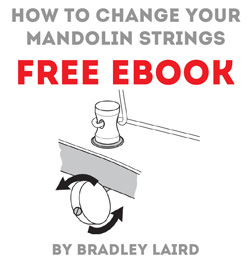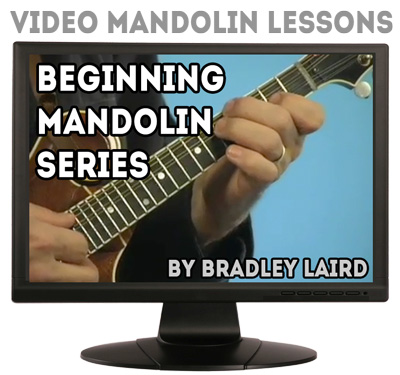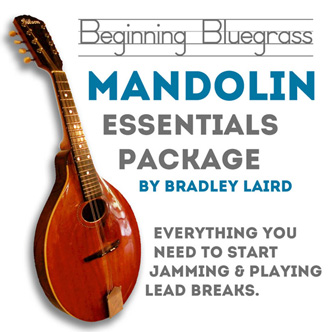|
HOME | FREE MANDOLIN CHORD CHARTS | FREE VIDEO LESSONS | FREE PODCAST FOR STUDENTS FREE BEGINNING MANDOLIN LESSONS | FREE MANDOLIN TABS | BRAD'S eBOOKS |
||||||
Download
Brad's FREE mandolin newsletters here... 
©2020 Bradley Laird |
FREE
MANDOLIN LESSON 2 - by Bradley Laird
HOW A MANDOLIN IS TUNED Before we continue talking about mandolin strings I should mention that if your strings are old, blackened or rusty they will be hard to keep in tune and will not sound very good. You can change them pretty easily if you use these instructions:
Now, back to our discussion of strings. The length of the full string is determined by the distance from the bridge to the nut. This is the "speaking" portion of the string. Since most mandolins are roughly the same size, and since you cannot easily alter this dimension, we will consider the length of the strings to be fixed. But, you should know that a string at a particular tension will increase in pitch if shortened. To take advantage of this we have string shortening devices placed on the fingerboard of the mandolin. They are the frets. Press the string down so that it bears upon the fret and we have altered the speaking length of the string and thereby altered the pitch as well. What a handy invention for rapidly changing the pitch of the string! The winding on the strings also have an affect on the pitch of the string, but like overall string length, it is impractical to alter this factor while playing. The more massive the winding on the string, the lower the pitch produced if string length and string tension remain constant. And since we are speaking of more massive windings, let us look at the fourth string, the G string. It has the same length, similar tension, and yet a lower note is produced. This is because the mass of the winding slows down the vibration of the string. FREE MANDOLIN TUNING NOTES APP My 8 year old son Jackson designed this app to help you tune. (Don't ask me how he did it!) Just click on each note and match your strings to the sound of that note. The green flag starts the app and the red stop sign stops it.
If that app doesn't work on your device here is the same recorded MP3 track with all of the notes. And, if you prefer computer generated tones I made one of those too.
If you'd like to watch a free video to help you tune here is a link. I also invite you to consider these beginner video lessons. Thousands of people have learned to play using these videos because they really work! In particular are my two most popular chord videos: Moveable Major & Minor Chords and Barre Chords & 7th Chords. If you need some help "in the picking department" Beginning Videos 1-4 might be just what you need! Click on the image below to read about them, watch free the demos and decide for yourself: Onward to lesson 3!
| |||||






